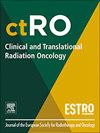保乳手术后低分割全乳照射同时整合肿瘤床强化与顺序强化的比较
IF 2.7
3区 医学
Q3 ONCOLOGY
引用次数: 0
摘要
背景与目的本研究旨在比较同时集成增压(SIB)和顺序增压(SeB)在低分割性脑损伤中的安全性和有效性。材料和方法本研究分析了两项前瞻性研究的数据,包括1132例pT1-3 N0-3 M0乳腺癌患者,其中775例接受SIB治疗,357例接受SeB治疗。处方剂量为43.5 Gy / 15次全乳和/或淋巴结区域,其中49.5 Gy / 15次(SIB)或8.7 Gy / 3次(SeB)递送至肿瘤床。结果分析包括生存结果、治疗相关毒性和美容结果。结果SIB与SeB的5年预后分别为:局部控制率97.8% vs. 98.8% (p = 0.12),局部区域控制率97.7% vs. 97.1% (p = 0.72),无病生存率94.1% vs. 93.1% (p = 0.71),总生存率97.4% vs. 97.1% (p = 0.88),乳房特异性生存率98.2% vs. 97.5% (p = 0.43)。治疗加权逆概率稳定后,组间差异仍不显著。在放疗前后,SIB组的美容效果一般或较差的比率较低,但美容效果恶化没有差异(9.8%对7.6%,p = 0.22)。2级或更高的毒性,包括皮肤毒性、肺炎、乳房肿胀、疼痛、硬化、淋巴水肿和肩部活动问题,组间具有可比性。结论sib是SeB的可行替代方案,具有相似的毒性特征和生存结果,同时缩短了治疗时间。有必要进行更长时间的随访以评估长期结果。本文章由计算机程序翻译,如有差异,请以英文原文为准。
Comparison of simultaneous integrated tumor bed boost and sequential boost during hypofractionated whole-breast irradiation after breast-conserving surgery
Background and purpose
This study aimed to compare the safety and efficacy of simultaneous integrated boost (SIB) and sequential boost (SeB) during hypofractionated WBI.
Materials and methods
This study analyzed data from two prospective studies, including 1,132 patients with pT1-3 N0-3 M0 breast cancer, of whom 775 received SIB and 357 received SeB. The prescribed dose was 43.5 Gy in 15 fractions to whole breast and/or nodal region, with either 49.5 Gy in 15 fractions (SIB) or 8.7 Gy in 3 fractions (SeB) delivered to tumor bed. Outcomes analyzed included survival outcomes, treatment-related toxicities, and cosmetic outcomes.
Results
The 5-year outcomes were local control rates of 97.8 % vs. 98.8 % (p = 0.12), locoregional control rates of 97.7 % vs. 97.1 % (p = 0.72), disease-free survival of 94.1 % vs. 93.1 % (p = 0.71), overall survival of 97.4 % vs. 97.1 % (p = 0.88), and breast-specific survival of 98.2 % vs. 97.5 % (p = 0.43) for SIB versus SeB, respectively. After stabilized inverse probability of treatment weighting, differences between groups remained non-significant. Rates of fair or poor cosmetic outcomes before and after radiotherapy were lower in the SIB group, but there was no difference in cosmetic deterioration (9.8 % vs. 7.6 %, p = 0.22). Grade 2 or higher toxicities, including skin toxicity, pneumonitis, breast swelling, pain, induration, lymphedema, and shoulder mobility issues, were comparable between groups.
Conclusion
SIB is a viable alternative to SeB, offering comparable toxicity profiles and survival outcomes while shortening treatment duration. Longer follow-up is warranted to assess long-term outcomes.
求助全文
通过发布文献求助,成功后即可免费获取论文全文。
去求助
来源期刊

Clinical and Translational Radiation Oncology
Medicine-Radiology, Nuclear Medicine and Imaging
CiteScore
5.30
自引率
3.20%
发文量
114
审稿时长
40 days
 求助内容:
求助内容: 应助结果提醒方式:
应助结果提醒方式:


